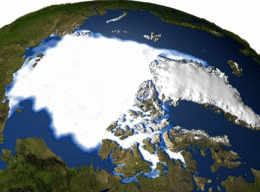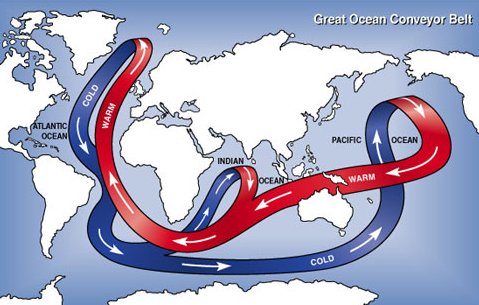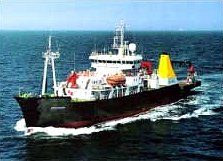|
March 5, 2004: Global
warming could plunge North America and Western Europe
into a deep freeze, possibly within only a few decades.
That's the paradoxical scenario
gaining credibility among many climate scientists. The
thawing of sea ice covering the Arctic could disturb or
even halt large currents in the Atlantic Ocean. Without
the vast heat that these ocean currents
deliver--comparable to the power generation of a million
nuclear power plants--Europe's average temperature would
likely drop 5 to 10°C (9 to 18°F), and parts of
eastern North America would be chilled somewhat less.
Such a dip in temperature would be similar to global
average temperatures toward the end of the last ice age
roughly 20,000 years ago.
 Right:
Retreating Arctic ice, 1979-2003, based on data
collected by the Defense Meteorological Satellite
Program (DMSP) Special Sensor Microwave Imager (SSMI). [More] Right:
Retreating Arctic ice, 1979-2003, based on data
collected by the Defense Meteorological Satellite
Program (DMSP) Special Sensor Microwave Imager (SSMI). [More]
Some scientists believe this shift in
ocean currents could come surprisingly soon--within as
little as 20 years, according to Robert Gagosian,
president and director of the Woods Hole Oceanographic
Institution. Others doubt it will happen at all. Even
so, the Pentagon is taking notice. Andrew Marshall, a
veteran Defense Department planner, recently released an
unclassified report detailing how a shift in ocean
currents in the near future could compromise national
security.
"It's difficult to predict what
will happen," cautions Donald Cavalieri, a senior
scientist at NASA's Goddard Space Flight Center,
"because the Arctic and North Atlantic are very
complex systems with many interactions between the land,
the sea, and the atmosphere. But the facts do suggest
that the changes we're seeing in the Arctic could
potentially affect currents that warm Western Europe,
and that's gotten a lot of people concerned."
Ice is Key
There are several satellites keeping an
all-weather watch on ice cover in the Arctic. NASA's
Aqua satellite, for instance, carries a Japanese-built
sensor called the Advanced Microwave Scanning
Radiometer-EOS ("AMSR-E" for short). Using
microwaves, rather than visible light, AMSR-E can
penetrate clouds and offer uninterrupted surveillance of
the ice, even at night, explains Roy Spencer, the
instrument's principal investigator at the Global
Hydrology and Climate Center in Huntsville, Alabama.
Other ice-watching satellites, operated by NASA, NOAA
and the Dept. of Defense, use similar technology.
The view from orbit clearly shows a
long-term decline in the "perennial" Arctic
sea ice (the part that remains frozen during the warm
summer months). According to a 2002 paper by Josefino
Comiso, a climate scientist at NASA's Goddard Space
Flight Center, this year-round ice has been retreating
since the beginning of the satellite record in 1978 at
an average rate of 9% per decade. Studies looking at
more recent data peg the rate at 14% per decade,
suggesting that the decline of Arctic sea ice is
accelerating.

Above:
A global ocean circulation between deep, colder water
and warmer, surface water strongly influences regional
climates around the world. Image courtesy Argonne
National Laboratory. [More]
Some scientists worry that melting
Arctic sea ice will dump enough freshwater into the
North Atlantic to interfere with sea currents. Some
freshwater would come from the ice-melt itself, but the
main contributor would be increased rain and snow in the
region. Retreating ice cover exposes more of the ocean
surface, allowing more moisture to evaporate into the
atmosphere and leading to more precipitation.
Because saltwater is denser and
heavier than freshwater, this "freshening" of
the North Atlantic would make the surface layers more
buoyant. That's a problem because the surface water
needs to sink to drive a primary ocean circulation
pattern known as the "Great Ocean Conveyor."
Sunken water flows south along the ocean floor toward
the equator, while warm surface waters from tropical
latitudes flow north to replace the water that sank,
thus keeping the Conveyor slowly chugging along. An
increase in freshwater could prevent this sinking of
North Atlantic surface waters, slowing or stopping this
circulation.
 AMSR-E
is collecting new data that will help scientists
evaluate this possibility. For one thing, it provides
greatly improved ground resolution over previous
all-weather sensors. AMSR-E images reveal smaller cracks
and fissures in the ice as it breaks up in the spring.
This detail allows scientists to better understand the
dynamics of ice break-up, says Cavalieri, a member of
the AMSR-E team. AMSR-E
is collecting new data that will help scientists
evaluate this possibility. For one thing, it provides
greatly improved ground resolution over previous
all-weather sensors. AMSR-E images reveal smaller cracks
and fissures in the ice as it breaks up in the spring.
This detail allows scientists to better understand the
dynamics of ice break-up, says Cavalieri, a member of
the AMSR-E team.
Right:
Sea ice disintegrating off the coast of Greenland on
March 15, 2003, as seen by the older Defense
Meteorological Satellite Program SSMI sensor (14 km
resolution) and the newer AMSR-E (~5 km resolution).
Smaller cracks not visible in the left image show up
clearly in the right one.
"Other important pieces of the
puzzle, like rainfall, sea-surface temperatures, and
oceanic winds, are also detected by AMSR-E. Looking at
those variables together should help scientists assess
the likelihood of a change in the Atlantic
currents," adds Spencer.
Deja Vu?
Once considered incredible, the notion
that climate can change rapidly is becoming respectable.
In a 2003 report,
Robert Gagosian cites "rapidly advancing evidence
[from, e.g., tree rings and ice cores] that
Earth's climate has shifted abruptly and dramatically in
the past." For example, as the world warmed at the
end of the last ice age about 13,000 years ago, melting
ice sheets appear to have triggered a sudden halt in the
Conveyor, throwing the world back into a 1,300 year
period of ice-age-like conditions called the
"Younger Dryas."
Will it happen again? Researchers are
scrambling to find out.
 On
Feb. 13, an expedition set sail from Great Britain to
place current-monitoring sensors in the Atlantic Ocean
that will check the Gulf Stream for signs of slowing.
The voyage is the latest step in a joint US / UK
research project called Rapid Climate Change, which
began in 2001. Another international project, called
SEARCH (Study of Environmental Arctic CHange), kicked
off in 2001 with the goal of more carefully assessing
changes in Arctic sea ice thickness. On
Feb. 13, an expedition set sail from Great Britain to
place current-monitoring sensors in the Atlantic Ocean
that will check the Gulf Stream for signs of slowing.
The voyage is the latest step in a joint US / UK
research project called Rapid Climate Change, which
began in 2001. Another international project, called
SEARCH (Study of Environmental Arctic CHange), kicked
off in 2001 with the goal of more carefully assessing
changes in Arctic sea ice thickness.
Above:
The RRS Discovery, on a voyage to measure currents in
the Atlantic Ocean. [More]
Much depends on how fast the warming
of the Arctic occurs, according to computer simulations
by Thomas F. Stocker and Andreas Schmittner of the
University of Bern. In their models, a faster warming
could shut down the major Atlantic current completely,
while a slower warming might only slow the current for a
few centuries.
And, inevitably, the discussion turns
to people. Does human industry play a major role in
warming the Arctic? Could we reverse the trend, if we
wanted to? Not all scientists agree. Some argue that the
changes occuring in the Arctic are consistent with
large, slow natural cycles in ocean behavior that are
known to science. Others see a greater human component.
"The sea ice thawing is
consistent with the warming we've seen in the last
century," notes Spencer, but "we don't know
how much of that warming is a natural climate
fluctuation and what portion is due to manmade
greenhouse gases."
If the Great Conveyor Belt suddenly
stops, the cause might not matter. Europeans will have
other things on their minds--like how to grow crops in
snow. Now is the time to find out, while it's merely a
chilling possibility.
|